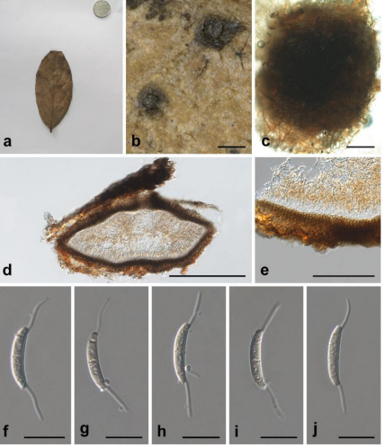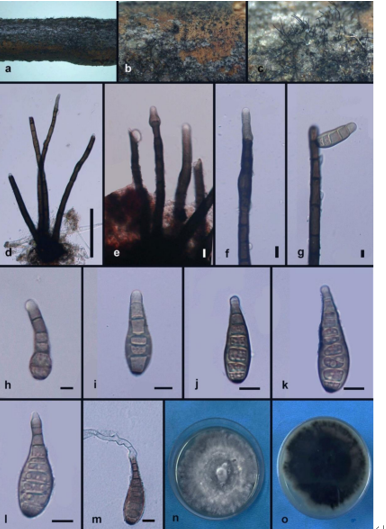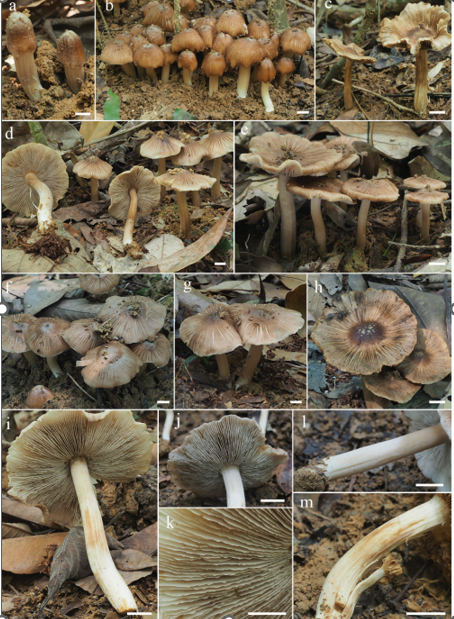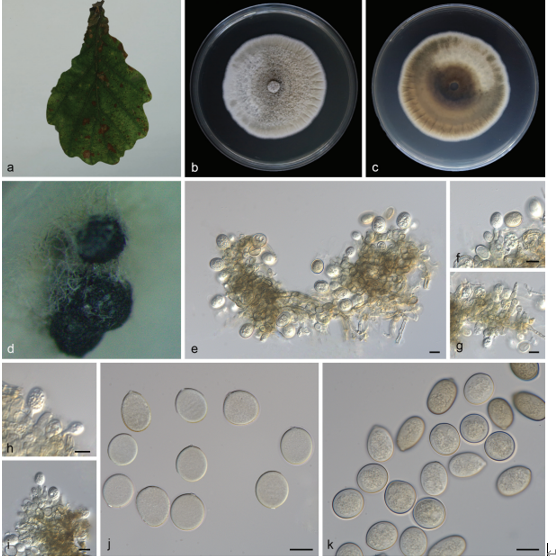Atractospora ellipsoidea Réblová & J. Fourn. 2021
MycoBank Facesoffungi number: FoF 09548
Holotype: WF18A (MFLU 18-1182), living culture KUMCC 18-0051; ibid., HKAS 101702.
Morphological description
Sexual morph:Ascomata 90–120 μm high, 120–140 μm diam., scattered, superficial, ellipsoidal, dark brown to black, lying horizontally on the substrate, coriaceous, ostiolate, with a lateral neck. Necks 40–60 μm long, black, cylindrical, curving upwards, comprising single layer of brown to dark brown cells of textura angularis. Peridium 8.5–12 μm thick at upper part, comprising 5–7 layers of brown to dark brown, thinwalled, compressed cells of textura angularis; 35–40 μm thick near the base where below the neck, comprising 9–11 layers of brown to dark brown, thick-walled, large cells of textura angularis. Paraphyses 5 μm diam., sparse, hypha-like, uneven subcylindrical, septate, constricted at septa, unbranched, hyaline. Asci 75–120 × 10–14 μm (x= 98 × 11.5 μm, n = 10), 8-spored, unitunicate, subcylindrical, wider in the middle part, apex slightly truncate, pedicellate, with a small, refractive apical ring, 2.7–3 × 2.3–2.5 μm. Ascospores 16–19 × 6–7.5 μm (x= 17.8 × 6.5 μm, n = 10), overlapping uniseriate, or partially biseriate in the middle part, hyaline when young, becoming pale brown when mature, ellipsoidal, rounded or slightly acute at both ends, straight or curved, two apices occasionally reverse bending, aseptate when young, 1-septate when mature, not constricted at septum, guttulate, thin-walled, smooth, without a mucilaginous sheath.
Asexual morphs:
Cultures: On PDA, colony circular, reaching 30 mm in 65 days at 25°C, graydark brown from above, dark brown to black from below, surface rough, dry, with sparse mycelium, flat, entire at edge.
Habitat: : on submerged wood in a stream.
Distribution: China, Yunnan Province, Pingbian City.
GenBank Accession: LSU = MW287772;ITS = MW286498; TEF = MW396655; RPB2 = MW504071.
Notes: Although the type material of Aquaticola ellipsoidea was unavailable for morphological examination, Réblová et al. (2016) transferred A. ellipsoidea to Atractospora based on original description (Ho et al. 1999b) and two reference sequences, AY590290 and AY316356 (Raja et al. 2003, Campbell & Shearer 2004). We name our new collection KUMCC 18-0051 as A. ellipsoidea considering its very similar morphological characteristics with the holotype (Ho et al. 1999b), except for septa of the ascospores. We observed 1-septate ascospores when mature, while they were aseptate in the holotype (Ho et al. 1999b). This is probably because the holotype was examined when young or large guttules obscured the septa (Réblová et al. 2016). In this study, we confirm A. ellipsoidea in Atractospora with morphological and molecular data derived from our new collection KUMCC 18-0051.
Reference: Dong W, Hyde KD, Jeewon R, Doilom M, Yu XD, Wang GN, Liu NG, Hu DM, Nalumpang S, Zhang H 2021 – Towards a natural classification of annulatascaceae-like taxa Ⅱ: introducing five new genera and eighteen new species from freshwater. Mycosphere 12(1), 1–88,
Doi 10.5943/mycosphere/12/1/1
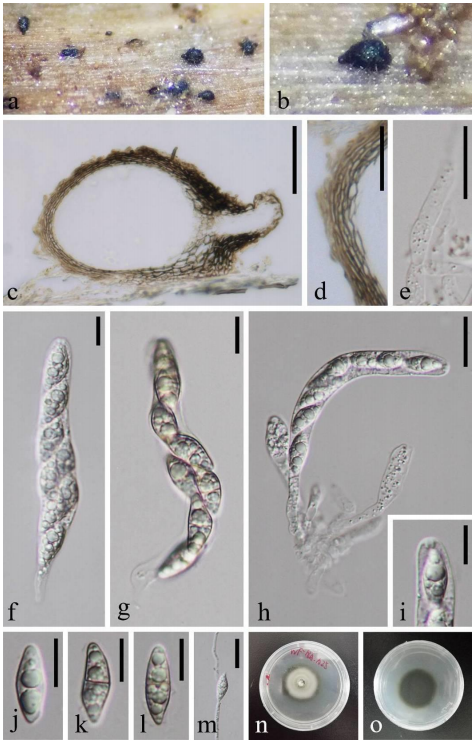
Atractospora ellipsoidea (MFLU 18-1182). a, b Ascomata on host substrate. c Vertical section of ascoma. d Structure of peridium. e Paraphyses. f–h Unitunicate asci. i Apical ring. j–l Ascospores. m Germinated ascospore. n, o Colony on PDA (left-front, right-reverse). Scale bars: c = 50 μm, d, e, h, m = 20 μm, f, g, i–l = 10 μm.


